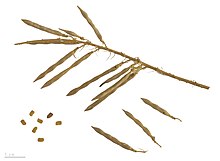
Metformin, sold under the brand name Glucophage, among others, is the main first-line medication for the treatment of type 2 diabetes, particularly in people who are overweight. It is also used in the treatment of polycystic ovary syndrome. It is sometimes used as an off-label adjunct to lessen the risk of metabolic syndrome in people who take antipsychotics. Metformin is not associated with weight gain and is taken by mouth.
Drugs used in diabetes treat diabetes mellitus by decreasing glucose levels in the blood. With the exception of insulin, most GLP-1 receptor agonists, and pramlintide, all diabetes medications are administered orally and are thus called oral hypoglycemic agents or oral antihyperglycemic agents. There are different classes of hypoglycemic drugs, and selection of the appropriate agent depends on the nature of diabetes, age, and situation of the person, as well as other patient factors.
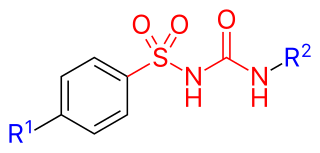
Sulfonylureas or sulphonylureas are a class of organic compounds used in medicine and agriculture. The functional group consists of a sulfonyl group (-S(=O)2) with its sulphur atom bonded to a nitrogen atom of a ureylene group (N,N-dehydrourea, a dehydrogenated derivative of urea). The side chains R1 and R2 distinguish various sulfonylureas. Sulfonylureas are the most widely used herbicide.

Saponaria officinalis is a common perennial plant from the family Caryophyllaceae. This plant has many common names, including common soapwort, bouncing-bet, crow soap, wild sweet William, and soapweed. There are about 20 species of soapworts altogether.
Guanidine is the compound with the formula HNC(NH2)2. It is a colourless solid that dissolves in polar solvents. It is a strong base that is used in the production of plastics and explosives. It is found in urine predominantly in patients experiencing renal failure. A guanidine moiety also appears in larger organic molecules, including on the side chain of arginine.

Exenatide, sold under the brand name Byetta among others, is a medication used to treat type 2 diabetes. It is used together with diet, exercise, and potentially other antidiabetic medication. It is a treatment option after metformin and sulfonylureas. It is given by injection under the skin.
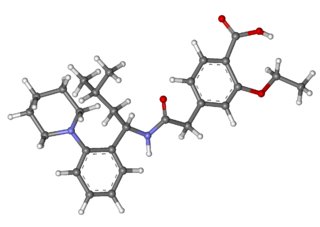
Repaglinide is an antidiabetic drug in the class of medications known as meglitinides, and was invented in 1983. Repaglinide is a medication used in addition to diet and exercise for blood sugar control in type 2 diabetes. The mechanism of action of repaglinide involves promoting insulin release from β-islet cells of the pancreas; like other antidiabetic drugs, a main side effect concern is hypoglycemia. It is sold by Novo Nordisk under the name of Prandin in the United States, Gluconorm in Canada, Surepost in Japan, Repaglinide in Egypt, and Novonorm elsewhere. In Japan it is produced by Dainippon Sumitomo Pharma.

Biguanide is the organic compound with the formula HN(C(NH)NH2)2. It is a colorless solid that dissolves in water to give highly basic solution. These solutions slowly hydrolyse to ammonia and urea.
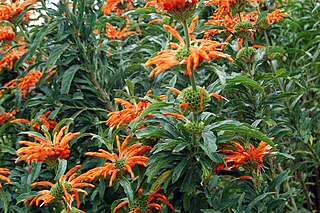
Leonotis leonurus, also known as lion's tail and wild dagga, is a plant species in the mint family, Lamiaceae. The plant is a broadleaf evergreen large shrub native to South Africa, where it is very common. It is known for its medicinal properties. The main psychoactive component of Leonotis leonurus is hypothesized to be related to the presence of leonurine or labdanes, Leonotis leonurus has been confirmed to contain Leonurine according to peer reviewed journal published phytochemical analysis. Like other plants in the mint family, it also contains marrubiin. The word "dagga" comes from Afrikaans, and derives in turn from the Khoikhoi "dachab". The word "dagga" has been extended to include cannabis in Afrikaans and South African English, so the use of "wild" serves to distinguish Leonotis leonuris from this.

Phenformin is an antidiabetic drug from the biguanide class. It was marketed as DBI by Ciba-Geigy, but was withdrawn from most markets in the late 1970s due to a high risk of lactic acidosis, which was fatal in 50% of cases.

Buformin (1-butylbiguanide) is an oral antidiabetic drug of the biguanide class, chemically related to metformin and phenformin. Buformin was marketed by German pharmaceutical company Grünenthal as Silubin.
Pioglitazone/metformin, sold under the brand name Actoplus Met among others, is a fixed-dose combination anti-diabetic medication used to improve glycemic control in adults with type 2 diabetes. It contains pioglitazone, a thiazolidinedione, and metformin, a biguanide.
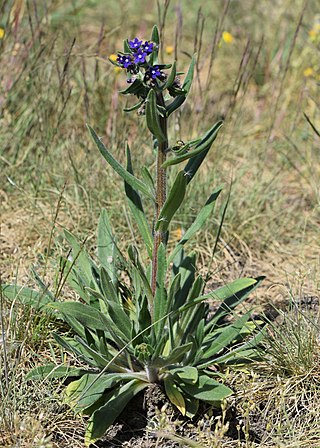
Anchusa officinalis, also knowns as common bugloss or common alkanet, is a species of flowering plant in the borage family. It is native to Europe and small parts of western Asia, but has been escaped from cultivation to grow in additional locations in Europe and the Americas. The flowers are noted for their popularity with bumblebees due to a large nectar flow. The plants have been used in traditional medicines, but were falling out of favor by the early 1800s. They are still planted in gardens for their popularity with bees and their blue flowers.

Officinalis, or officinale, is a Medieval Latin epithet denoting organisms—mainly plants—with uses in medicine, herbalism and cookery. It commonly occurs as a specific epithet, the second term of a two-part botanical name. Officinalis is used to modify masculine and feminine nouns, while officinale is used for neuter nouns.
Synthalin was an oral anti-diabetic drug. Discovered in 1926 it was marketed in Europe by Schering AG of Berlin as a synthetic drug with insulin-like properties that could be taken orally. However, it was toxic to the liver and kidney and was withdrawn from the market in the early 1940s.
Charles Joseph Tanret was a French pharmacist and chemist.

Galega, goat's rue, is a genus of flowering plants in the legume family, Fabaceae, native to central and southern Europe, western Asia and tropical east Africa. They are tall, bushy, herbaceous perennials with erect racemes of pea-like flowers in shades of white, pink, blue or mauve. Their preferred habitats are sunny damp meadows or slopes.

Galegine is a toxic chemical compound that has been isolated from Galega officinalis. It has also been found to be the principal cause of the toxicity of poison sedge.
Dapagliflozin/Saxagliptin is a combination medication designed to help manage diabetes mellitus, a chronic condition that affects how the body handles glucose (sugar). This medication combines two active ingredients, dapagliflozin/Saxagliptin, to address different aspects of diabetes control. Dapagliflozin/Saxagliptin sold under the brand name Qtern. It is a combination of dapagliflozin and saxagliptin. It is taken by mouth.
Bexagliflozin, sold under the brand name Brenzavvy, is an antidiabetic medication used to improve glycemic control in adults with type 2 diabetes. It is a sodium-glucose cotransporter 2 (SGLT2) inhibitor that is taken by mouth.

